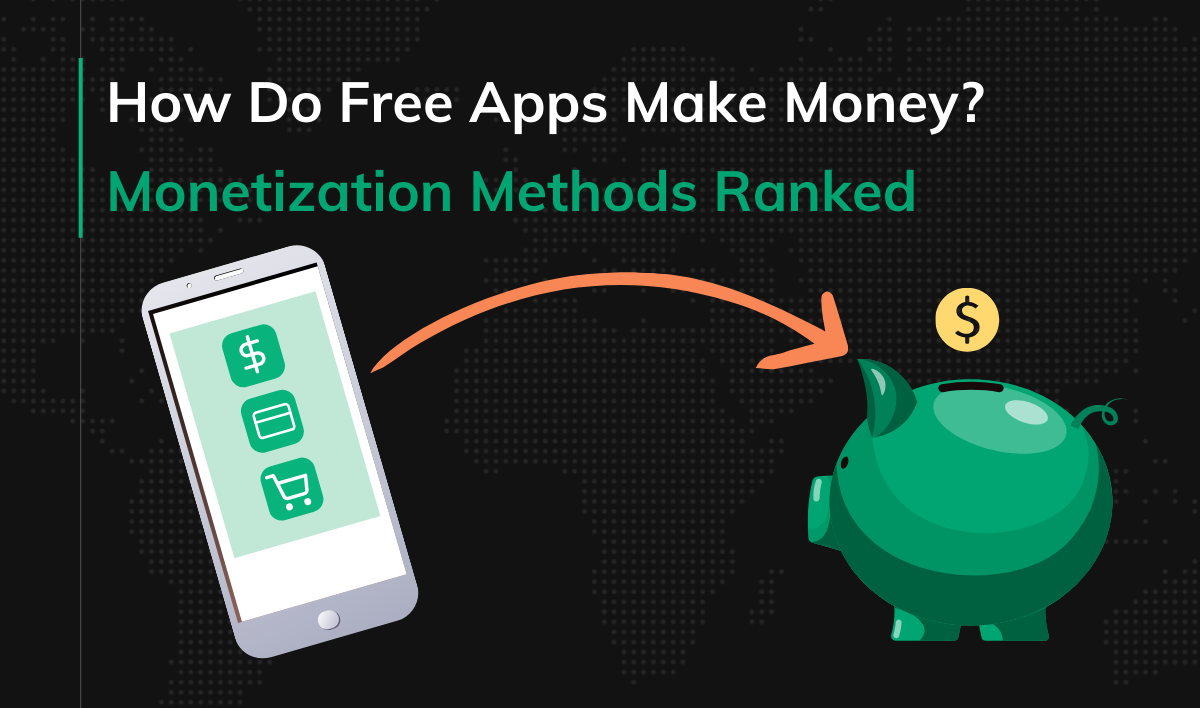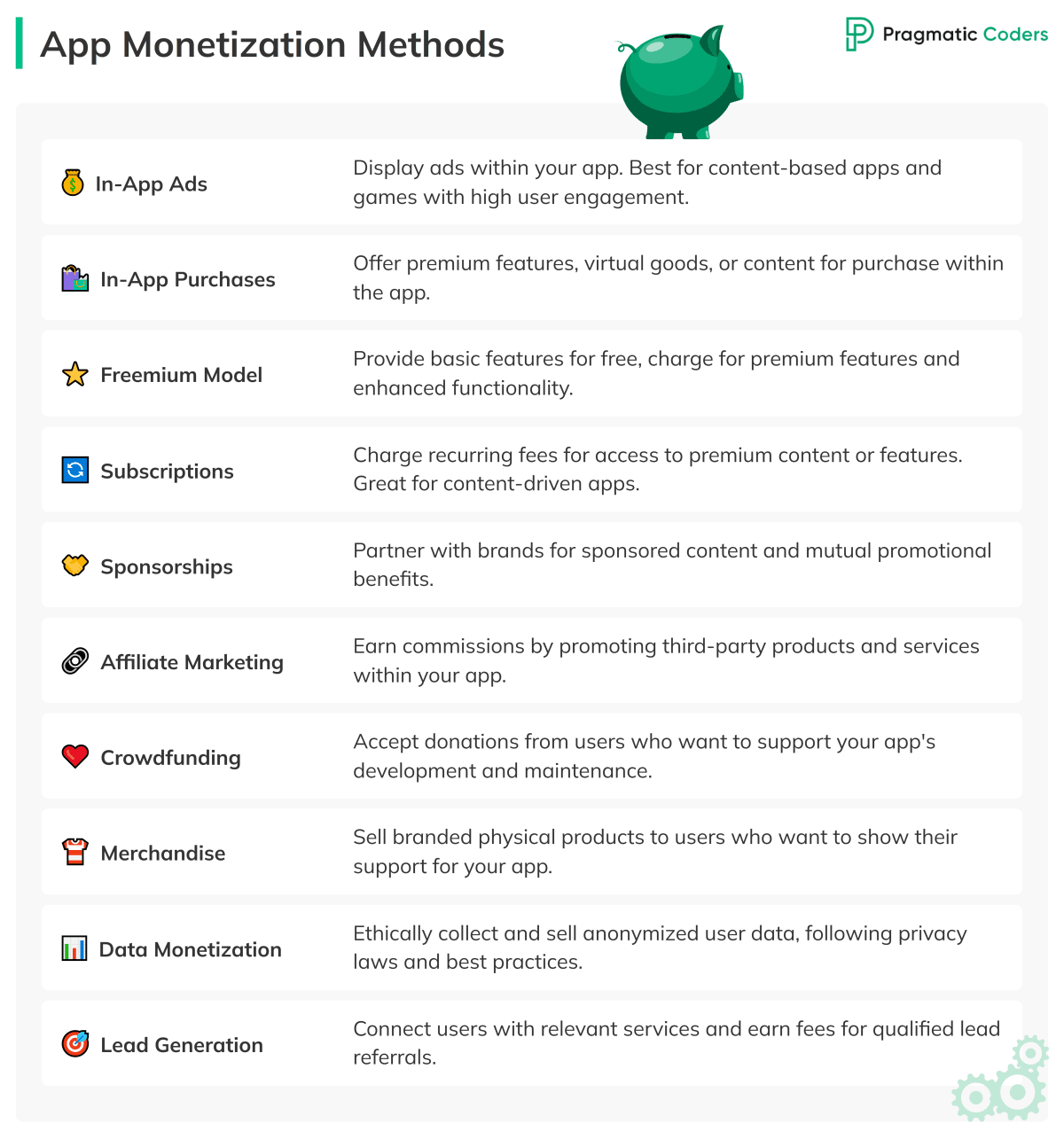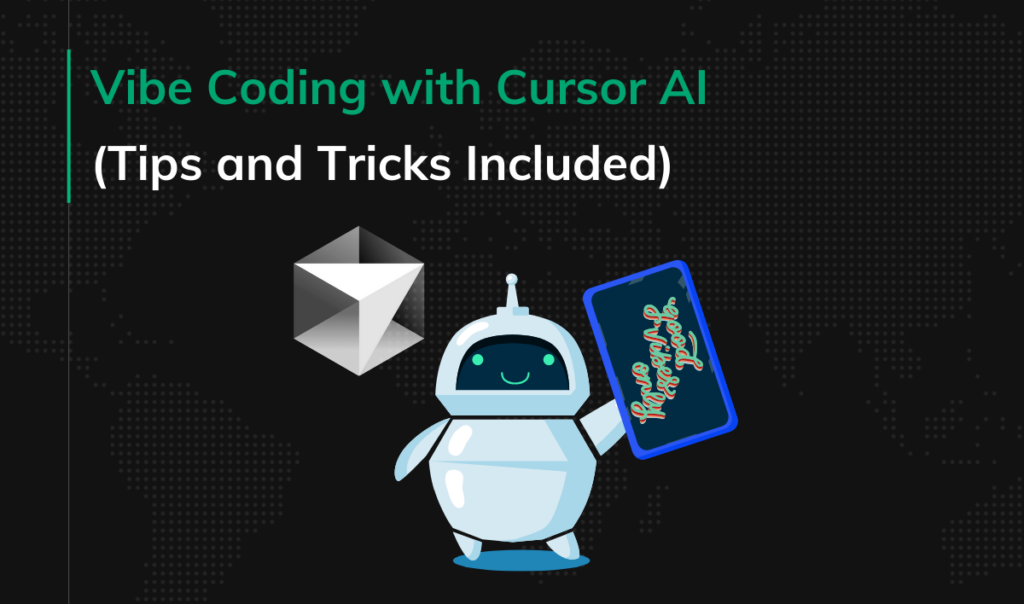How Do Free Apps Make Money? Monetization Methods Ranked

Ever wondered how free apps make money? You’re not alone. Many businesses and entrepreneurs exploring app development ask this question. In this guide, we’ll delve into the top monetization methods for free mobile apps. We’ll rank them based on revenue potential, impact on user experience (UX), and user perception. Let’s dive in!
Key Points
|
Paid vs. Free Apps: Which Model Suits You?
Choosing between a paid and a free app model is crucial. It affects your user base and revenue streams. Proper UX research can help you decide. Let’s break down the differences.
Pros and Cons of Paid Apps
Pros:
| Cons:
|
Paid apps require users to pay before downloading. This creates a barrier to entry. Only users convinced of the app’s value will purchase it. While this means fewer downloads, each one generates revenue. However, users paying upfront expect high quality. Negative reviews can hurt sales quickly.
Pros and Cons of Free Apps
Pros:
| Cons:
|
Free apps remove the initial barrier. Users can try your app without risk. This leads to more downloads and a larger user base. Monetization happens within the app through various strategies. However, earning revenue depends on how users interact with your app. You’ll need to continuously optimize your monetization methods.
Why Choose the Free Model?
The free model lowers barriers to entry. More users mean more revenue opportunities. With the right strategy, free apps can outperform paid ones. Need an example? Candy Crush Saga made over $20 BILLION with its freemium model. Free apps can build a large user base quickly. This opens doors to various monetization methods.
If you aim for growth and scalability, the free model is worth considering. It allows for creative ways to generate income while providing value to users. You can adapt and combine different monetization strategies to maximize earnings.
Top Free Mobile App Monetization Methods
Let’s rank the best monetization strategies for free apps. We’ll consider revenue potential, effect on UX, and user perception.
1. In-App Advertising
In-app ads are a popular choice. They generate revenue by displaying ads to users.
Revenue Potential: High, if you have a large user base. Solid user acquisition strategy is needed here.
Effect on UX: Can be intrusive if overused.
User Perception: Acceptable when not overwhelming.
Implementation Suggestions:
- Use Native Ads: These blend with your app content, making them less intrusive.
- Limit Ad Frequency: Avoid bombarding users with ads.
- Choose the Right Formats: Banner, interstitial, and video ads serve different purposes.
- Opt for Rewarded Videos: Users watch ads in exchange for in-app rewards.
Best Suited For:
- Content-Based Apps: News, blogs, or entertainment apps.
- Games: Especially casual games with high engagement.
- Social Apps: Where users spend significant time.
Tips: Monitor user feedback to adjust ad placements. Use analytics to optimize ad performance. Partner with reputable ad networks to ensure quality ads.
2. In-App Purchases
Offer extra features or content for a price. Users can enhance their experience by buying these extras. Don’t forget about a solid in-app payment system.
Revenue Potential: High, especially with valuable offerings.
Effect on UX: Enhances experience if done right.
User Perception: Positive when value is clear.
Implementation Suggestions:
- Exclusive Content: Offer levels, items, or features not available in the free version.
- Consumable Purchases: Items users can buy repeatedly, like virtual currency.
- Non-Consumable Purchases: Permanent additions, like removing ads.
- Balance Free and Paid Content: Ensure free users still enjoy the app.
Best Suited For:
- Games: Virtual goods, power-ups, or levels.
- Productivity Apps: Advanced features or tools.
- Educational Apps: Additional courses or resources.
Tips: Clearly communicate the value of in-app purchases. Avoid creating a “paywall” that frustrates users. Offer occasional discounts or bundles to encourage purchases.
3. Freemium Model
The basic app is free; premium features cost money. Users can choose to upgrade for additional benefits.
Revenue Potential: Moderate to high.
Effect on UX: Users can try before they buy.
User Perception: Generally positive.
Implementation Suggestions:
- Highlight Premium Features: Show what users gain by upgrading.
- Seamless Upgrade Process: Make it easy to purchase premium versions.
- Regular Updates: Add new features to keep users interested.
- Free Trial Periods: Let users experience premium features temporarily.
Best Suited For:
- Music Streaming Apps: Access to ad-free listening or exclusive tracks.
- Cloud Services: More storage or advanced functionalities.
- Fitness Apps: Personalized plans or detailed analytics.
Tips: Don’t cripple the free version; it should be valuable on its own. Use prompts to remind users of premium features without being pushy.
4. Subscription Model
Charge users a recurring fee for premium access. Subscriptions provide steady income over time.
Revenue Potential: Steady and predictable.
Effect on UX: High expectations for content and service.
User Perception: Willing if content is valuable.
Implementation Suggestions:
- Free Trials: Offer a taste of premium content.
- Exclusive Content: Provide something users can’t get elsewhere.
- Flexible Plans: Monthly, yearly, or family subscriptions.
- Easy Management: Allow users to cancel or modify subscriptions easily.
Best Suited For:
- Video Streaming Apps: Access to a library of movies and shows.
- News Apps: Premium articles or ad-free browsing.
- Educational Platforms: Courses, tutorials, or certifications.
Tips: Keep content fresh to retain subscribers. Offer personalized recommendations to enhance value. Communicate updates and new features regularly.
5. Sponsorships and Partnerships
Collaborate with brands for mutual benefit. Brands pay to reach your user base.
Revenue Potential: Variable, depends on partnerships.
Effect on UX: Can enhance experience if relevant.
User Perception: Positive if content aligns with interests.
Implementation Suggestions:
- Relevant Collaborations: Partner with brands that fit your app’s theme.
- Sponsored Content: Integrate brand messages naturally.
- In-App Events: Host challenges or contests sponsored by brands.
- Transparency: Inform users about sponsorships.
Best Suited For:
- Fitness Apps: Partnering with sports brands.
- Travel Apps: Collaborations with airlines or hotels.
- Lifestyle Apps: Working with fashion or beauty brands.
Tips: Ensure partnerships add value to the user experience. Avoid overwhelming users with branded content. Measure the impact of partnerships on engagement.

6. Affiliate Marketing
Promote products and earn commissions. When users buy through your app, you get paid.
Revenue Potential: Moderate.
Effect on UX: Acceptable if products are relevant.
User Perception: Positive when recommendations are genuine.
Implementation Suggestions:
- Contextual Recommendations: Suggest products that fit user needs.
- Quality Products: Only promote items you trust.
- Clear Disclosures: Be upfront about affiliate relationships.
- Value-Added Content: Provide reviews or tutorials.
Best Suited For:
- Shopping Apps: Curated lists or deals.
- Recipe Apps: Linking to cooking utensils or ingredients.
- Travel Apps: Booking accommodations or tours.
Tips: Track affiliate links to see what’s effective. Update offers to keep content fresh. Respect user trust by avoiding spammy promotions.
7. Crowdfunding and Donations
Users donate to support the app. This works well for apps with loyal communities. Learning more about how crowdfunding works is crucial for this one.
Revenue Potential: Low to moderate.
Effect on UX: Minimal impact.
User Perception: Positive among dedicated users.
Implementation Suggestions:
- Donation Buttons: Place them in accessible areas.
- Explain the Need: Tell users how donations help improve the app.
- Offer Recognition: Thank donors publicly if appropriate.
- Small Perks: Provide exclusive content or features to donors.
Best Suited For:
- Open-Source Apps: Where development relies on community support.
- Community Apps: Platforms fostering user connections.
- Niche Tools: Serving specific professional needs.
Tips: Keep donation requests humble. Show how contributions make a difference. Engage with your community to build loyalty.
8. Selling Merchandise
Offer branded products to users. Merchandise can strengthen your brand. But… you have to have a brand in the first place.
Revenue Potential: Variable, depending on demand and brand recognition.
Effect on UX: Minimal if integrated well.
User Perception: Positive if products are appealing.
Implementation Suggestions:
- Branded Items: T-shirts, mugs, or accessories featuring your logo.
- In-App Storefront: Easy browsing and purchasing.
- Limited Editions: Create urgency and exclusivity.
- Promotions: Offer discounts or bundle deals.
Best Suited For:
- Gaming Apps: Fans may want merchandise featuring characters.
- Entertainment Apps: For shows or personalities.
- Social Apps: Where community identity is strong. A great choice for influencers.
Tips: Use high-quality products to reflect well on your brand. Promote merchandise subtly within the app. Consider user feedback for new product ideas.
9. Data Monetization
Collect and sell anonymized user data. This must be done ethically and legally.
Revenue Potential: Moderate to high.
Effect on UX: Can be concerning if not transparent.
User Perception: Wary if privacy isn’t respected.
Implementation Suggestions:
- Transparency: Clearly state data collection policies.
- Anonymization: Remove personal identifiers.
- Opt-In Options: Allow users to consent.
- Compliance: Adhere to laws like GDPR or CCPA.
Best Suited For:
- Analytics Apps: Collecting usage statistics.
- Health Apps: Gathering anonymized health data.
- Market Research Apps: Providing insights to businesses.
Tips: Prioritize user trust. Offer value in exchange for data sharing, like personalized experiences. Regularly review practices to maintain compliance.
10. Lead Generation
Collect user info for third parties. Businesses pay for qualified leads.
Revenue Potential: Moderate.
Effect on UX: Can be intrusive if not handled carefully.
User Perception: Acceptable if value is provided.
Implementation Suggestions:
- Value Exchange: Offer something useful, like a free report.
- Relevant Offers: Match third-party services to user needs.
- Consent: Obtain clear permission to share information.
- Privacy: Protect user data diligently.
Best Suited For:
- Finance Apps: Connecting users to loan providers.
- Real Estate Apps: Linking to agents or property listings.
- Job Search Apps: Sharing profiles with recruiters.
Tips: Be selective with partners to ensure quality. Keep the process simple to avoid user frustration. Monitor the impact on user retention.
Combining Monetization Methods
Using multiple monetization strategies can boost your app’s revenue and increase user engagement. Here are three effective examples that combine strategies we’ve discussed in this guide.
1. In-App Advertising and In-App Purchases
Why They Work Together:
- Diversified Income: In-app ads generate revenue from all users, while in-app purchases (IAPs) monetize engaged users willing to pay for extra features.
- User Choice: Offers flexibility; users can support the app by viewing ads or purchasing enhancements.
- Enhanced Engagement: IAPs can increase user interaction, leading to more ad impressions.
How to Implement:
- Balanced Integration: Place banner ads in non-intrusive areas. Use interstitial ads sparingly to avoid disrupting the user experience.
- Enticing In-App Purchases: Offer valuable items, features, or content that enhance the app’s functionality or enjoyment.
- Ad Removal Option: Provide an IAP to remove ads for users who prefer an ad-free experience.
2. Freemium Model and Subscription Services
Why They Work Together:
- Upselling Opportunities: The freemium model allows users to try basic features for free, while subscriptions offer access to premium features.
- Steady Revenue: Subscriptions provide a predictable, recurring income stream.
- User Retention: Regularly updated premium content encourages users to maintain their subscriptions.
How to Implement:
- Tiered Features: Offer essential functionalities in the free version and unlock advanced features with a subscription.
- Free Trials: Allow users to experience premium features for a limited time to encourage subscription sign-ups.
- Continuous Improvement: Add new content or features to the premium version to retain subscribers.
3. Sponsorships and Affiliate Marketing
Why They Work Together:
- Additional Revenue Streams: Sponsorships provide income through partnerships, while affiliate marketing earns commissions from promoted products.
- Enhanced User Experience: Relevant sponsored content and affiliate products can add value for users.
- Brand Credibility: Collaborations with reputable brands can boost user trust.
How to Implement:
- Relevant Partnerships: Choose sponsors and affiliate products that align with your app’s niche and user interests.
- Seamless Integration: Incorporate sponsored content and affiliate links naturally within the app.
- Transparency: Clearly disclose partnerships to maintain user trust.
How to Choose the Optimal Monetization Model
Selecting the right strategy is key. The optimal model depends on your app and audience. The choice is not easy, as we’ve counted over 60 business model patterns!
Factors to Consider
App TypeDifferent apps suit different monetization methods.
| User BaseUnderstand your audience’s preferences.
|
Market CompetitionAnalyze what competitors are doing.
| User Engagement LevelHigh engagement allows more monetization opportunities.
|
Scenarios and Examples
Scenario 1: A Casual Game App
- Situation: High engagement, users love the game.
- Recommendation: Use in-app purchases for game items. Introduce rewarded video ads for extra lives. Think Candy Crush Saga.
- Reasoning: Gamers are willing to pay for enhancements. Rewarded ads don’t disrupt gameplay and provide value.
Scenario 2: A Fitness Tracking App
- Situation: Users seek advanced features.
- Recommendation: Implement a freemium model. Offer basic tracking for free, premium features for subscribers. Check out Fiit for a solid freemium model example.
- Reasoning: Health enthusiasts may pay for detailed analytics. The free version attracts users who may upgrade later.
Scenario 3: A News Aggregator App
- Situation: Users consume content daily.
- Recommendation: Use in-app advertising. Partner with brands for sponsored content. Check out Google News.
- Reasoning: Regular content consumption allows for ad revenue. Relevant sponsored articles enhance user experience.
Scenario 4: A Language Learning App
- Situation: Users want to learn new languages effectively.
- Recommendation: Offer a subscription model with a free trial. Provide premium lessons and personalized coaching. Yes, I’ll just link to Duolingo here.
- Reasoning: Serious learners are willing to pay for quality content. A free trial builds trust and showcases value.
General Strategy
Align your strategy with user expectations.
- Gamers: Accustomed to in-app purchases and ads.
- Professionals: Prefer subscriptions for premium features.
- Casual Users: More tolerant of ads if content is free.
Consider the balance between revenue and user experience. Overloading with ads can drive users away. Offering too much for free might reduce revenue. Find the sweet spot that maximizes both user satisfaction and earnings. Prototyping app UIs with AI allows you to design interfaces quickly. This enables you to test multiple monetization integrations and identify the one that offers the best user experience.
Test different strategies to see what works best. Use analytics to track performance. Be ready to adjust based on user feedback and data insights.
Conclusion
Monetizing a free app isn’t a one-size-fits-all process. Consider your app’s nature and your users’ preferences. Choose a strategy that offers value without compromising user experience.
Stay adaptable. The app market evolves quickly. What works today might change tomorrow. Keep an eye on industry trends and be willing to innovate.
Remember, the most successful apps often use a combination of strategies. Don’t be afraid to mix and match. With the right approach, your free app can become a profitable venture.
Focus on providing value. Happy users are more likely to engage with your monetization methods. Build trust and maintain high-quality content or services.
By thoughtfully selecting and implementing monetization strategies, you’ll set your app up for success. Good luck on your journey to monetizing your free app!




